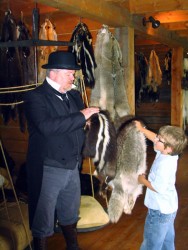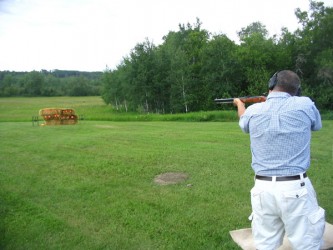Article Origin
Volume
Issue
Year
From muzzle-loading and knife throwing to a ride on a Red River ox-cart, Fort Carlton Provincial Park was an interesting place to be this summer. Starting as a fur trading post in 1810, the 200th birthday of the fort is a great time to experience Aboriginal history first-hand.
Fort Carlton was a main fur-trading post for most of its first 75 years. Lorraine Harder, Senior Interpreter at the park notes that celebrating the fur trade era during the 125th anniversary of the events of 1885 is important because it shows the equal partnership between First Nations and Europeans.
“It’s a good counterpoint to the 1885 story,” she said. “At other places like Batoche and Fish Creek, it is a story of struggle for First Nations and Métis. But fur trading is from an earlier time period and it really was a much more equal partnership.”
The fur trading re-enactment portrays the diplomacy required by the Europeans in order to trade for furs with local First Nations. Included in this was the gift exchange ceremony, which was multi-faceted, and essential to creating a relationship.
“The First Nations in that time period had a lot of power,” said Harder, “and to keep them from going to another fort, or to the North West Company, the Hudson’s Bay Company really had to work very hard to keep First Nations’ business. There was a lot of ‘rolling out of the red carpet’ and a lot of diplomacy involved.”
John Peter Pruden established Fort Carlton in 1810 and was the chief fur buyer for the next 25 years. He married a Cree woman and raised – depending on the accounts – seven children. All his children went into the fur trade, and the descendants return this summer to celebrate their ancestor.
Pruden worked very hard to maintain First Nations’ business, and to ensure the Fort was successful. Many of his practices were widely adopted and the relationship that the Hudson’s Bay Company had with the First Nations at Fort Carlton became a model for other areas.
“A lot of the concessions that the First Nations Chiefs asked for in Treaty 6,” said Harder. “Were based on their experience with the Hudson’s Bay Company, at places like Fort Carlton. For example the medicine chest, which first appears in Treaty 6 was based on their experience in Fort Carlton. They had been receiving treatment against small pox, and vaccinations here at Fort Carlton beginning in the early 1800’s. Also, they could leave their elderly here when they were travelling long distances, and they left their sick.”
Today, the staff at Fort Carlton is always willing to learn, Harder said, and the Aboriginal community has much to contribute.
“We try to incorporate Cree into our interpretations,” she said. “So I try to learn Cree when I can. Visitors tell us what it was like when they were hunting and trapping. When the kids come from up north we like to ask if they’ve gone trapping with their mooshums, or find out how much they know too, because sometimes the visitor can teach us as well.”
There are many layers of history at Fort Carlton and its importance as a meeting place was confirmed when it became the signing location for Treaty #6. Yet long before the fur traders, the area was Pehonanihk, Cree for ‘the meeting place’ or ‘the waiting place’.
“This was a river valley where the First Nations would follow the buffalo,” said Harder. “It’s an easy place to cross to the north, so they would gather in this river flat, have their family gathering, do their trading, and visit. The fur traders found that out and set up their post here.”
For the same reasons, the area is part of the Carlton trail, which in turn was based on an old First Nations trail between the easiest place to cross the North and the South Saskatchewan Rivers. This made Fort Carlton one of the pivotal forts in the region, along with Fort Pitt, Fort Edmonton, Lower Fort Garry, and Fort York. It was only the development of the rail line through other areas that changed the course of history. Yet the park is still a meeting place, with its beautiful riverside setting, rolling fields and whispering aspen bluffs, bordered by thickets of saskatoons.
On July 18th, events included a fur trapping display and demonstrations, with furs from weasels to fishers, skunks, bear cubs, raccoons, coyotes, foxes, and wolves. Trappers skinned animals on site, including a coyote and a beaver. There were also blacksmithing demonstrations and the ever popular bannock bake and pemmican sampling.
A relay race with a twist had competitors wear and hand off the Hudson’s Bay coat and sash, after completing their event. The events were trap setting, (with 3 mousetraps), a snowshoe race (on green grass), a dog sled race (with a toboggan pulled by team members and the snowshoe runner sitting on the sled), followed by buffalo hide folding, which is then hauled with a leather head strap to the Red River cart to complete the race.
- 2565 views


